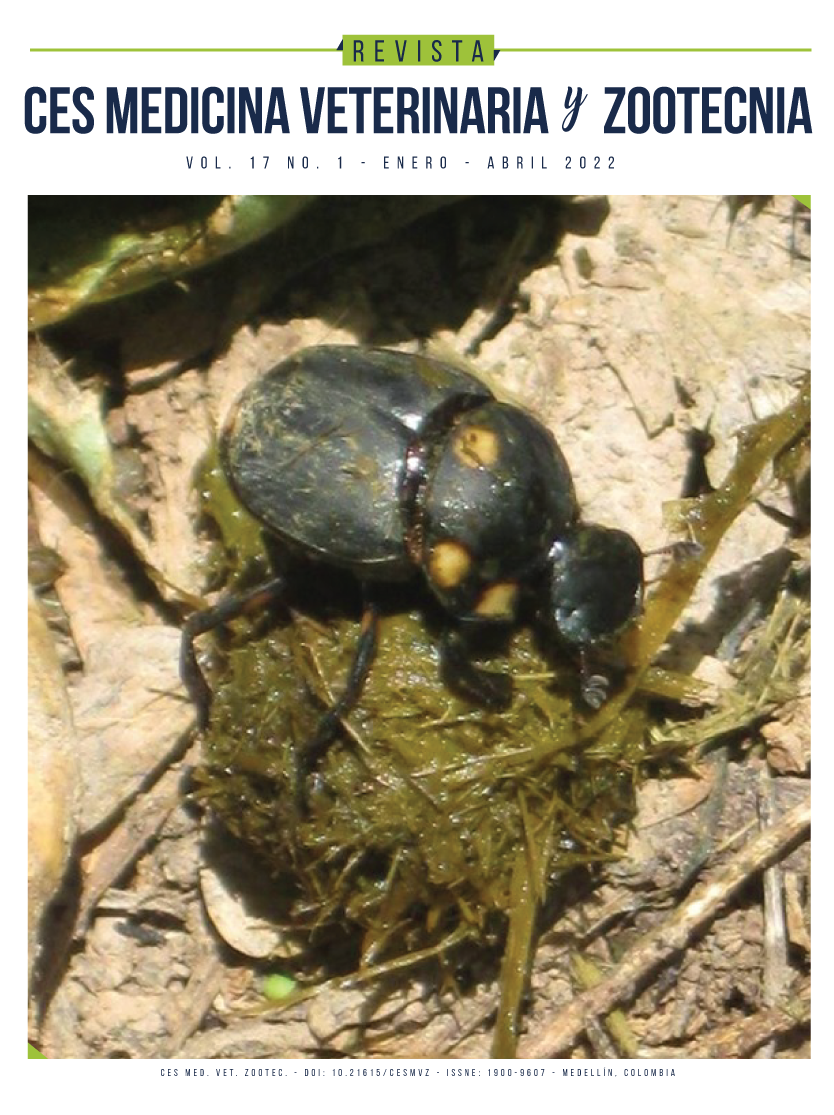In vitro assay of Lippia graveolens and Lippia alba extracts against Aeromonas spp isolated from tilapia (Oreochromis niloticus)
DOI:
https://doi.org/10.21615/cesmvz.6452Keywords:
Aeromonas hydrophila, Aeromonas sobria, antimicrobial activity, aquacultureAbstract
This study evaluated the antimicrobial activity of Lippia graveolens and Lippia alba extracts and essential oils against nine strains of Aeromonas spp., isolated from Oreochromis niloticus. The crude extracts were obtained by percolation technique and CO2 supercritical fluid extraction, while the essential oils by applying hydro-distillation technique using a Clevenger apparatus. The antimicrobial activity for each extract and essential oils was verified through the disc diffusion method at 24 hours. The essential oil of L. graveolens showed higher effectiveness to inhibit fish bacterial pathogens (100%) than the extracts, revealing an inhibition zone diameter that ranged from 25.20 - 36.94 mm. The extracts from supercritical fluid and from the percolation technique with ethyl acetate and cyclohexane presented the same effectiveness (77.78%). The crude extract obtained with ethanol 95% showed limited antimicrobial effect (22.22%), presenting the smallest inhibition zone (ranged from 8.34 to 9.57 mm). On the other hand, L. alba displayed a lower antibacterial activity, being the essential oil 66.67% effective, presenting an inhibition zone ranging between 10.68 to 16.29 mm. The result of this study indicates that essential oils from both L. graveolens and L. alba offer a promising alternative for the control of Aeromonas spp. growth.
Downloads
References
Adams RP. Identification of essential oil components by gas chromatography/mass spectrometry. 4ta ed. USA: Carol Stream, IL: Allured publishing corporation; 2007.
Adame-Gallegos JR, Andrade-Ochoa S, Nevarez-Moorillon GV. Potential Use of Mexican Oregano Essential Oil against Parasite, Fungal and Bacterial Pathogens. Journal of Essential Oil Bearing Plants 2016; 19(3): 553–567.
Alagawany M, Farag MR, Salah AS, Mahmoud MA. The role of oregano herb and its derivatives as immunomodulators in fish. Reviews in Aquaculture 2020; 12(4): 2481-2492.
Anastasiou TI, Mandalakis M, Krigas N, Vézignol T, Lazari D, Katharios P, et al. Comparative Evaluation of Essential Oils from Medicinal-Aromatic Plants of Greece: Chemical Composition, Antioxidant Capacity and Antimicrobial Activity against Bacterial Fish Pathogens. Molecules 2020; 25(1): 148.
Ara N, Nur, MH, Amran MS, Wahid MII, Ahmed M. In vitro Antimicrobial and Cytotoxic Activities of Leaves and Flowers Extracts from Lippia alba. Pakistan Journal of Biological Sciences 2009, 12: 87-90.
Arana-Sánchez A, Estarrón-Espinosa M, Obledo-Vázquez EN, Padilla-Camberos E, Silva-Vázquez R, Lugo-Cervantes E. Antimicrobial and antioxidant activities of Mexican oregano essential oils (Lippia graveolens H. B. K.) with different composition when microencapsulated inβ-cyclodextrin. Letters in Applied Microbiology 2010; 50(6): 585–590.
Bostock J, McAndrew B, Richards R, Jauncey K, Telfer T, Lorenzen K, Corner R. Aquaculture: global status and trends. Philosophical Transactions of the Royal Society of London. Series B, Biological Sciences 2010; 365: 2897–2912.
Burt S. Essential oils: Their antibacterial properties and potential applications in foods. International Journal of Food Microbiology 2004; 94(1): 223–253.
Calvo-Irabién LM, Parra-Tabla V, Acosta-Arriola V, Escalante-Erosa F, Díaz-Vera L, Dzib GR, et al. Phytochemical Diversity of the Essential Oils of Mexican Oregano (Lippia graveolens Kunth) Populations along an Edapho-Climatic Gradient. Chemistry & Biodiversity 2014; 11(7): 1010–1021.
Chakraborty SB, Hancz C. Application of phytochemicals as immunostimulant, antipathogenic and antistress agents in finfish culture. Reviews in Aquaculture 2011; 3(3): 103-119.
Cáceres A. Plantas de uso medicinal en Guatemala (No. 633.88097281 C118). 1era ed. Guatemala; Editorial Universitaria; 1996.
Conde-Hernández LA, Espinosa-Victoria JR, Trejo A, Guerrero-Beltrán JÁ. CO2 supercritical extraction, hydrodistillation and steam distillation of essential oil of rosemary (Rosmarinus officinalis). Journal of Food Engineering 2017; 200: 81–86.
Cunha ALB, Chaves FCM, Bizzo HR, Souza AM. Caracterizacao quimica do oleo essencial de ervacidreira, nas condicoes de Manaus, AM. Horticultura Brasileira 2012; 30(2): S5780–S5784.
Davies J, Davies D. Origins and evolution of antibiotic resistance. Microbiology and Molecular Biology Reviews 2010; 74(3): 417-433.
De Souza RC, de Souza EM, da Costa MM, Melo JFB, Baldisserotto B, Copatti CE. Dietary addition of the essential oil from Lippia alba to Nile tilapia and its effect after inoculation with Aeromonas spp. Aquaculture Nutrition 2019; 25(1): 39-45.
Dong HT, LaFrentz B, Pirarat N, Rodkhum C. Phenotypic characterization and genetic diversity of Flavobacterium columnare isolated from red tilapia, Oreochromis sp., in Thailand. Journal of Fish Diseases 2014; 38(10): 901-913.
Dong HT, Nguyen VV, Le HD, Sangsuriya P, Jitrakorn S, Saksmerprome V, et al. Naturally concurrent infections of bacterial and viral pathogens in disease outbreaks in cultured Nile tilapia (Oreochromis niloticus) farms. Aquaculture 2015; 448(1): 427-435.
Dong HT, Senapin S, Jeamkunakorn C, Nguyen VV, Nguyen NT, Rodkhum C, et al. Natural occurrence of edwardsiellosis caused by Edwardsiella ictaluri in farmed hybrid red tilapia (Oreochromis sp.) in Southeast Asia. Aquaculture 2019; 499: 17-23.
Espinosa A, Bermúdez MC. La acuicultura y su impacto al medio ambiente. Estudios Sociales: Revista de alimentación contemporánea y desarrollo regional 2012; 1(2): 221-232.
FAO. El estado mundial de la pesca y la acuicultura 2020. La sostenibilidad en acción 2020; [Access June 30th of 2021], doi.org/10.4060/ca9229es.
Fischer U, Lopez R, Pöll E, Vetter S, Novak J, Franz CM. Two chemotypes within Lippia alba populations in Guatemala. Flavour and Fragrance Journal 2004; 19(4): 333–335.
García-Pérez J, Marroquín-Mora D. Evaluación in vitro de extractos de plantas medicinales como posibles agentes antimicrobianos para bacterias patógenas en tilapia. Kuxulkab' 2021; 27(57): 27-35.
Helander IM, Alakomi HL, Latva-Kala K, Mattila-Sandholm T, Pol I, Smid EJ, et al. Characterization of the action of selected essential oil components on Gram-negative bacteria. Journal of Agricultural and Food Chemistry 1998; 46(9): 3590-3595.
Hernández-Contreras Á, Hernández MD. Application of aromatic plants and their extracts in aquaculture. Feed Additives 2020; 239–259.
Karousou R, Kokkini S. The genus Origanum (Labiatae) in Crete: distribution and essential oils. Bocconea 2003; 16, 717–721.
Kačániová M, Terentjeva M, Vukovic N, Puchalski C, Roychoudhury S, Kunová S, et al. The antioxidant and antimicrobial activity of essential oils against Pseudomonas spp. isolated from fish. Saudi Pharmaceutical Journal 2017; 25(8): 1108-1116.
Lambert RJW, Skandamis PN, Coote PJ, Nychas GJ. A study of the minimum inhibitory concentration and mode of action of oregano essential oil, thymol and carvacrol. Journal of Applied Microbiology 2001; 91(3): 453-462.
Loaiza-Salguero ES, Ortíz SD, Robles E. Extracción supercrítica con CO2. Bachelor Thesis, Facultad de Ciencias Químicas y Farmacia, Universidad de San Carlos de Guatemala, Guatemala, 1994, 74 p.
Love DC, Rodman S, Neff RA, Nachman KE. Veterinary drug residues in seafood inspected by the European Union, United States, Canada, and Japan from 2000 to 2009. Environmental Science and Technology 2011; 45: 7232–7240.
Majolo C, da Rocha SIB, Campos E, Maia FC, Ribeiro H. Chemical composition of Lippia spp. essential oil and antimicrobial activity against Aeromonas hydrophila. Aquaculture Research 2016; 48(5): 2380-2387.
Majolo C, Pilarski F, Chaves FCM, Bizzo HR, Chagas EC. Antimicrobial activity of some essential oils against Streptococcus agalactiae, an important pathogen for fish farming in Brazil. Journal of Essential Oil Research 2018; 1–10.
Martínez-Natarén DA, Parra-Tabla V, Ferrer-Ortega MM, Calvo-Irabién LM. Genetic diversity and genetic structure in wild populations of Mexican oregano (Lippia graveolens HBK) and its relationship with the chemical composition of the essential oil. Plant Systematics and Evolution 2014; 300(3): 535-547.
Mo WY, Chen Z, Leung HM, Leung AOW. Application of veterinary antibiotics in China´s aquaculture industry and their potential human health risks. Environmental Science and Pollution Research 2017; 24: 8978-8989.
More SJ. European perspectives on efforts to reduce antimicrobial usage in food animal production. Irish Veterinary Journal 2020; 73(1): 2.
Olivero-Verbel J, Barreto-Maya A, Bertel-Sevilla A, Stashenko EE. Composition, anti-quorum sensing and antimicrobial activity of essential oils from Lippia alba. Brazilian Journal of Microbiology 2014; 45(3): 759-767.
Olusola SE, Emikpe BO, Olaifa FE. The potentials of medicinal plant extracts as bio-antimicrobials in aquaculture. International Journal of Medicinal and Aromatic Plants 2013; 3(3): 404 - 412.
Pérez-Sabino JF, Mérida-Reyes M, Farfán-Barrera CD, Silva AJRD. Análise e discriminaçao de quimiotipos de Lippia graveolens HBK da Guatemala por microextraçao em fase sólida, CG-EM e análise multivariada. Química Nova 2012; 35(1): 97-101.
Picón-Camacho SM, Marcos-Lopez M, Beljean A, Debeaume S, Shinn AP. In vitro assessment of the chemotherapeutic action of a specific hydrogen peroxide, peracetic, acetic, and peroctanoic acid-based formulation against the free-living stages of Ichthyophthirius multifiliis (Ciliophora). Parasitology research 2012; 110(2): 1029-1032.
R Core Team. R: A language and environment for statistical computing. R Foundation for Statistical Computing, Austria. 2020; [access February 2 of 2021]. https://www.R-project.org/.
Reverter M, Bontemps N, Lecchini D, Banaigs B, Sasal P. Use of plant extracts in fish aquaculture as an alternative to chemotherapy: Current status and future perspectives. Aquaculture 2014; 433: 50–61.
Rico A, Phu TM, Satapornvanit K, Min J, Shahabuddin AM, Henriksson PJG, Murray FJ, Little DC, Dalsgaard A, Van den Brink PJ. Use of veterinary medicines, feed additives and probiotics in four major internationally traded aquaculture species farmed in Asia. Aquaculture 2013; 412-413, 231–243.
Ribas-Pilau M, Hartz S, Weiblen R, Arenhart S, Cueto AP, Lovato LT. Antiviral activity of the Lippia graveolens (Mexican oregano) essential oil and its main compound carvacrol against human and animal viruses. Brazilian Journal of Microbiology 2011; 42(4): 1616-1624.
Salgueiro L, Cavaleiro C, Gonçalves M, Proença da Cunha A. Antimicrobial Activity and Chemical Composition of the Essential Oil of Lippia graveolens from Guatemala. Planta Medica 2013; 69(01): 80–83.
Sarker SD, Nahar L, Editor. An Introduction to Natural Products Isolation. 1 er ed. India: Humana Press, 2012.
Sena JG, Melo JG, Saraiva AM, Gonçalves AM, Psiottano MNC, Xavier HS. Antimicrobial activity and phytochemical profile from the roots of Lippia alba (Mill.) NE Brown. Revista Brasileira de Farmacognosia 2006; 16(4): 506-509.
Shankar-Murthy K, Kiran BR, Venkateshwarlu M. A review on toxicity of pesticides in Fish. International Journal of Open Scientific Research 2013; 1(1): 15-36.
Sutili FJ, Velasquez A, Pinheiro CG, Heinzmann BM, Gatlin III DM, Baldisserotto B. Evaluation of Ocimum americanum essential oil as an additive in red drum (Sciaenops ocellatus) diets. Fish & Shellfish Immunology 2016; 56: 155-161.
Sutili F, Gatlin DM, Heinzmann BM, Baldisserotto B. Plant essential oils as fish diet additives: benefits on fish health and stability in feed. Reviews in Aquaculture 2017; 0, 1-12.
Starliper CE, Ketola HG, Noyes AD, Schill WB, Henson FG, Chalupnicki MA, et al. An investigation of the bactericidal activity of selected essential oils to Aeromonas spp. Journal of Advanced Research 2015; 6(1): 89-97.
Standley PC. Flora of Guatemala. 1er ed, Vol. 24, Part IX. Field Museum of Natural History, 1970.
Stratev D, Zhelyazkov G, Noundou XS, Krause RWM. Beneficial effects of medicinal plants in fish diseases. Aquaculture International 2018; 26: 289–308.
Tavares ES, Juliao LS, Lopes D, Bizzo HR, Lage CLS, Leitao SG. Analysis of the essential oil from~ leaves of three Lippia alba (Mill.) N. E. Br. (Verbenaceae) chemotypes cultivated on the same conditions. Revista Brasileira de Farmacognosia 2005; 15: 1–5.
Tkachenko H, Buyun L, Terech-Majewska E, Osadowski Z. In vitro antimicrobial activity of ethanolic extracts obtained from Ficus spp. leaves against the fish pathogen Aeromonas hydrophila. Archives of Polish Fisheries 2016; 24(4): 219-230.
Valladão GMR, Gallani SU, Pilarski F. Phytotherapy as an alternative for treating fish disease. Journal of Veterinary Pharmacology and Therapeutics 2014; 38(5): 417-428.
Zengin H, Baysal A. Antibacterial and antioxidant activity of essential oil terpenes against pathogenic and spoilage-forming bacteria and cell structure-activity relationships evaluated by SEM microscopy. Molecules 2014; 19(1): 17773 –17798.
Zoghbi MGB, Andrade EHA, Santos AS, Silva MH, Maia JGS. Essential oils of Lippia alba (Mill) N. E. Br growing wild in the Brazilian Amazon. Flavour and Fragrance Journal 1998; 13: 47–48.
Zhu F. A review on the application of herbal medicines in the disease control of aquatic animals. Aquaculture 2020; 735422.
Downloads
Published
How to Cite
Issue
Section
License
Copyright (c) 2022 CES Medicina Veterinaria y Zootecnia

This work is licensed under a Creative Commons Attribution-NonCommercial-ShareAlike 4.0 International License.
| Article metrics | |
|---|---|
| Abstract views | |
| Galley vies | |
| PDF Views | |
| HTML views | |
| Other views | |



